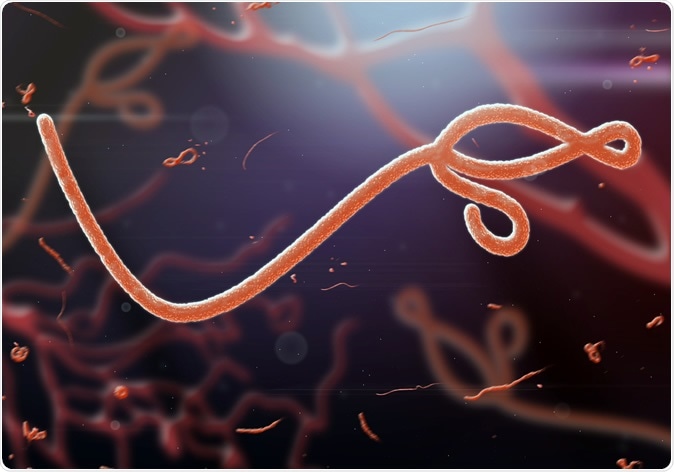The Ebola virus produces widely varying reactions, from asymptomatic illness to death, in people depending on the individual's susceptibility. But what drives this difference in response? A new study published in the journal Cell Reports in February 2020 goes one step further in understanding how the immune system reacts to the virus causing varying levels of severity of disease between cases.

Ebola virus. Image Credit: Jaddingt / Shutterstock
The study
The new paper describes the work of a team at Columbia University's Center for Infection and Immunity in a specialized laboratory mouse population, bred to show humanoid immune reactions to the Ebola virus. The research will help understand which of the numerous human immune pathways predict the outcomes in Ebola-infected people.
The mice were first infected with Ebola, and the immune response analyzed. The differences between the survivors and those who died of the infection were identified. The next step was to layout how different genes were expressed in different ways between these groups and how this accounted for the immune response going in opposite directions in the two groups.
The data was then fed into a computer to drive a machine learning program. The output led to the creation of a pioneering AI model that can reliably predict the outcome of a human disease, based on how a small set of genes are expressed.
Testing it out
The researchers tested this model with a real-life dataset, obtained from actual Ebola patients in West Africa. This data describes the RNA types that are linked to immune function in the blood of patients. The outcome of disease in these patients was also available.
When this data was supplied to the model, the predicted outcomes correlated to the actual results in 75% of cases. In other words, the mouse model allowed the researchers to identify the right factors that drove the clinical course of infection in humans as well.
This experiment was made possible by the availability of human data on gene expression collected during an actual Ebola outbreak. In most cases, this type of research is limited because samples taken at such times containing this type of data are difficult to obtain. This data set is among the very few that are actually in existence.
Using mouse models to study human disease
Researcher, Atsushi Okamura, comments, "Human data collected during an outbreak rarely contains the combined breadth and specificity of information scientists need to perform detailed analyses of immune function. Mouse models can help fill in the information gaps."
Another researcher, Angela Rasmussen, explains, "A common criticism of mouse models of Ebola is that they don't faithfully recapitulate human infection, and thus can't be used to develop diagnostic or prognostic tools. Here we show that data generated in our mouse model can be applied to patient data to predict outcomes correctly."
The good thing about mouse models is that they are cheaper, faster and give useful results that can be used to set the trajectory for the study of viral disease in humans and the development of better medications. The value of the present study is that it shows the reliability of a model developed in mice to predict outcomes in human disease.
The ability to usefully employ mouse models could, therefore, lead to more research in this area. The advantages include the feasibility of carrying out preclinical studies in high-security laboratory facilities, and the ability to use more experimental animals to achieve higher statistical power at a lower cost than is possible with the use of larger animals. And finally, the use of machine learning helps to obtain more realistic models even in the absence of enough human samples.
Implications
The model is not yet ready for application in humans. Still, it could be developed into useful tools to classify patients with Ebola into those who are likely to have a severe or fatal disease and those who are not at risk in countries where medical resources are scarce. It could also help to choose which patients need a boost in their immune function because they are at very high risk, even before they develop signs of severe disease. Thirdly, it could help to select patients who must be vaccinated due to their being at the highest risk.
Rasmussen says, "Since the current Ebola therapeutics being tested in the DRC [Democratic Republic of Congo] are most effective when given as early as possible in infection, our model could be used to develop tests with a huge impact on clinical care and patient outcomes."
Finally, the mouse model's ability to reflect human immune responses to Ebola could help understand how other viruses like the infamous novel coronavirus outbreak now making news in China affect the human immune system, and to guide the development of therapeutics.
Journal reference:
Transcriptional Correlates of Tolerance and Lethality in Mice Predict Ebola Virus Disease Patient Outcomes Price, Adam et al. Cell Reports, Volume 30, Issue 6, 1702 - 1713.e6, https://www.cell.com/cell-reports/fulltext/S2211-1247(20)30035-8